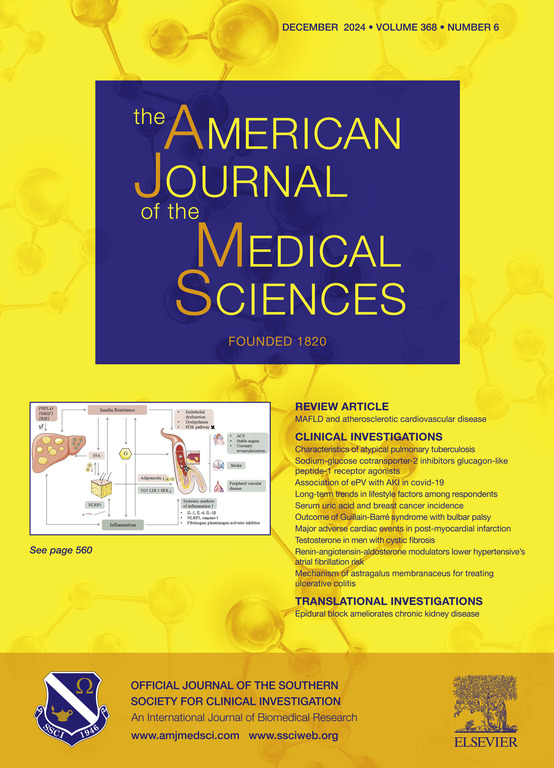Associations between psoriasis, psoriatic arthritis and gout or hyperuricemia: A systematic review and meta-analysis
IF 2.3
4区 医学
Q2 MEDICINE, GENERAL & INTERNAL
引用次数: 0
Abstract
Background
Uric acid (UA) has been associated with an increased incidence of psoriasis (PsO) and psoriatic arthritis (PsA). Clinical evidence shows that patients with PsO often have elevated serum UA levels, contributing to HUA and gout. This study investigated the bidirectional relationships among hyperuricemia (HUA), gout, PsO, and PsA through a systematic review and meta-analysis.
Objectives
To evaluate the associations between PsO, PsA, and the risks of HUA and gout.
Materials and Methods
PubMed, Embase, CNKI, and Wanfang databases were searched for relevant literature published from databases inception until February 2024.Quality was assessed using the Newcastle-Ottawa Scale (NOS).
Results
A total of 8 studies were included. Eligible studies included case-control, cohort, and cross-sectional studies.The meta-analysis showed that patients with PsO had a 2.56-fold higher risk of HUA [OR = 2.56, 95 % CI (1.82–3.59)] while PsA patients had a 3.56-fold higher risk of HUA [OR = 3.56, 95 % CI (2.04–6.20)]. The risk of gout was 4.95 times higher in PsA [OR = 4.95, 95 % CI (2.72–9.01)] and 1.95 times higher in PsO [OR = 1.95, 95 % CI (1.02–3.75)].
Conclusions
This study demonstrated a bidirectional relationship between psoriasis, psoriatic arthritis and gout or hyperuricemia, highlighting the need for clinicians to consider these conditions in managing the studied diseases.
银屑病、银屑病关节炎与痛风或高尿酸血症之间的关系:一项系统综述和荟萃分析。
背景:尿酸(UA)与银屑病(PsO)和银屑病关节炎(PsA)的发病率增加有关。临床证据表明,PsO患者血清UA水平经常升高,导致HUA和痛风。本研究通过系统综述和荟萃分析探讨了高尿酸血症(HUA)、痛风、PsO和PsA之间的双向关系。目的:评价PsO、PsA与HUA和痛风风险之间的关系。材料与方法:检索PubMed、Embase、CNKI、万方等数据库自建库至2024年2月发表的相关文献。使用纽卡斯尔-渥太华量表(NOS)评估质量。结果:共纳入8项研究。符合条件的研究包括病例对照、队列研究和横断面研究。荟萃分析显示,PsO患者发生HUA的风险高出2.56倍[OR = 2.56,95% CI (1.82-3.59)], PsA患者发生HUA的风险高出3.56倍[OR = 3.56,95% CI(2.04-6.20)]。PsA组痛风风险高4.95倍[OR = 4.95,95% CI (2.72 ~ 9.01)], PsO组痛风风险高1.95倍[OR = 1.95,95% CI(1.02 ~ 3.75)]。结论:本研究表明银屑病、银屑病关节炎和痛风或高尿酸血症之间存在双向关系,强调临床医生在治疗所研究疾病时需要考虑这些情况。
本文章由计算机程序翻译,如有差异,请以英文原文为准。
求助全文
约1分钟内获得全文
求助全文
来源期刊
CiteScore
4.40
自引率
0.00%
发文量
303
审稿时长
1.5 months
期刊介绍:
The American Journal of The Medical Sciences (AJMS), founded in 1820, is the 2nd oldest medical journal in the United States. The AJMS is the official journal of the Southern Society for Clinical Investigation (SSCI). The SSCI is dedicated to the advancement of medical research and the exchange of knowledge, information and ideas. Its members are committed to mentoring future generations of medical investigators and promoting careers in academic medicine. The AJMS publishes, on a monthly basis, peer-reviewed articles in the field of internal medicine and its subspecialties, which include:
Original clinical and basic science investigations
Review articles
Online Images in the Medical Sciences
Special Features Include:
Patient-Centered Focused Reviews
History of Medicine
The Science of Medical Education.

 求助内容:
求助内容: 应助结果提醒方式:
应助结果提醒方式:


